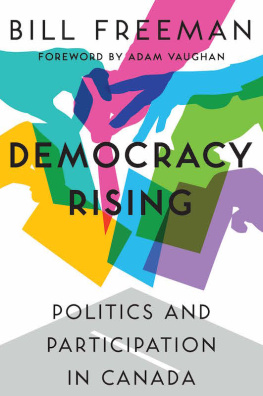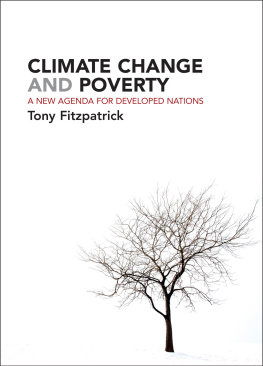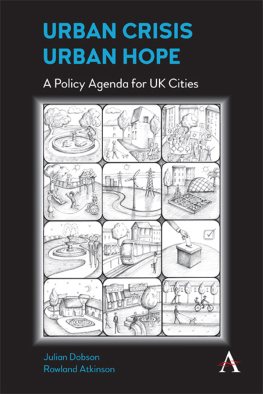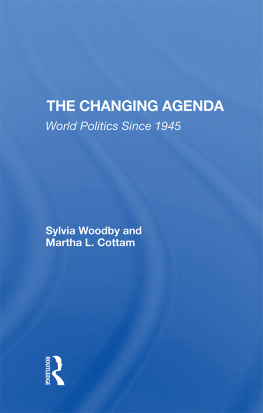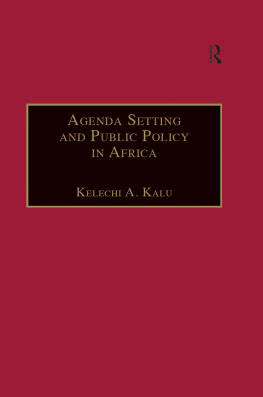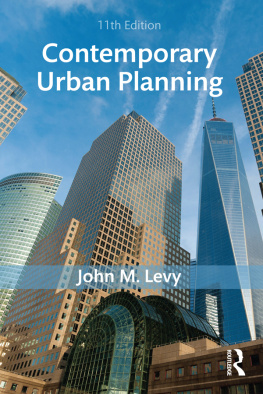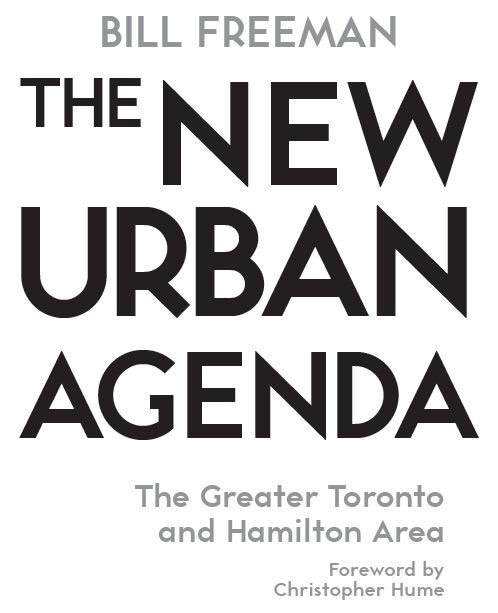Copyright
Copyright 2015 Bill Freeman
All rights reserved. No part of this publication may be reproduced, stored in a retrieval system, or transmitted in any form or by any means, electronic, mechanical, photocopying, recording, or otherwise (except for brief passages for purposes of review) without the prior permission of Dundurn Press. Permission to photocopy should be requested from Access Copyright.
Editor: Michael Melgaard
Design: Courtney Horner
Cover Design: Laura Boyle
Epub Design: Carmen Giraudy
Library and Archives Canada Cataloguing in Publication
Freeman, Bill, 1938-, author
The new urban agenda : the greater Toronto and Hamilton area / Bill
Freeman ; foreword by Christopher Hume.
Issued in print and electronic formats.
ISBN 978-1-4597-3109-7
1. City planning--Political aspects--Ontario--Toronto Region. 2. City
planning--Ontario--Toronto Region--Citizen participation. 3. Toronto
(Ont.)--Politics and government--21st century--Citizen participation.
4. Hamilton (Ont.)--Politics and government--21st century--Citizen
participation. 5. Toronto (Ont.)--Social conditions--21st century.
6. Hamilton (Ont.)--Social conditions--21st century. I. Hume, Christopher,
1951-, writer of supplementary textual content II. Title.
HT169.C22T581875 2015 307.121609713541 C2015-901262-7
C2015-901263-5
We acknowledge the support of the Canada Council for the Arts and the Ontario Arts Council for our publishing program. We also acknowledge the financial support of the Government of Canada through the Canada Book Fund and Livres Canada Books, and the Government of Ontario through the Ontario Book Publishing Tax Credit and the Ontario Media Development Corporation.
Care has been taken to trace the ownership of copyright material used in this book. The author and the publisher welcome any information enabling them to rectify any references or credits in subsequent editions.
J. Kirk Howard, President
The publisher is not responsible for websites or their content unless they are owned by the publisher.
Visit us at: Dundurn.com
@dundurnpress
Facebook.com/dundurnpress
Pinterest.com/dundurnpress
Dedication
To the people of the Greater Toronto and Hamilton Area
and the hope for progressive change
Foreword
If Bill Freemans The New Urban Agenda tells us anything, it is that Toronto can no longer take its success for granted. For a number of reasons, which Freeman outlines in clear, concise but conversational prose, the future of Canadas largest city and the vast region that surrounds it is threatened. The problem, of course, is us. But, as he points out, we can also be the solution.
Underlying the situation are the growing urban/suburban solitudes that divide the Greater Toronto and Hamilton Area (GTHA). In the aftermath of the so-called Megacity created in 1998 when Conservative premier Mike Harris forcibly amalgamated towns and cities across Ontario those divisions took on new significance. Politicians from the city and the suburbs found themselves sitting side by side in newly formed councils. Not surprisingly, these shotgun political marriages only made things worse. The most dramatic example of the new tensions was the four years that followed the election of Rob Ford as mayor of Toronto in 2010.
Though Freeman takes heart from Fords departure, he is quick to point out how the governance structure throughout the GTHA and Canada for that matter leaves our cities creatures of the province, largely impotent and certainly underfunded.
But it is local communities that know whats in their own best interests. They need help and organizational support, Freeman writes, but they can do it themselves, and in doing this their connection to their community deepens and becomes more meaningful.
Though transit is close to the top of Freemans New Urban Agenda, he also insists we need to empower communities and deepen democratic practices. At the same time, he doesnt shy away from proposing measures that would surely be met with outrage. Disincentives to driving will be politically difficult, he asserts, but it must be done or the enormous investments in transit could be wasted.
This book is exactly the sort of commonsensical discussion the GTHA so badly needs. Stripped of jargon and political non-speak, Freemans observations and arguments remind us that before we can solve our problems, we must be able to talk about them. The New Urban Agenda is a valuable next step in that direction.
Christopher Hume
Toronto, 2015
Introduction
The Toronto-Centred Region
Much of Toronto heaved a sigh of relief with the election of John Tory as mayor in November of 2014. Former mayor Rob Ford had brought division and intimidation to city council, along with ideas more appropriate for the 1950s and an out-of-control lifestyle. But politics are more than politicians getting along happily together.
Can John Tory be a progressive force? Will he champion innovative programs that create a sustainable, affordable city? That is what we need, but Im not optimistic Tory will be the man to do it. He is a lawyer and a businessman who believes the market will sort things out. His SmartTrack plan ignores the pressing transit problems of the suburbs. His first policy announcements as mayor emphasized making the city more navigable for cars. In the election he rarely spoke about cycling, creating a safe city for pedestrians, the growing problem of poverty, or new initiatives in planning.
And what about the other politicians in this sprawling city of ours? During the 2014 election there was a lot of talk about traffic gridlock, but nothing about how cars are a major contributor to climate change. There were dozens possibly hundreds of politicians making promises that taxes would not be raised, but little discussion of how we can create an affordable city where the quality of life in our neighbourhoods is the prime objective.
We have to think differently about our city and its problems. We have to begin by recognizing that a new city has emerged that is quite different from the old. Without most of us recognizing it, the Greater Toronto and Hamilton Area (GTHA) has emerged as the fourth largest urban centre in North America. With a population of 7.3 million people, only New York (18.9 million), Los Angeles (17.8 million), and Chicago (9.8 million) are larger.
Toronto is the financial capital of Canada. All five of the countrys largest banks have their head offices along Bay Street. The Toronto Stock Exchange (TSE) is the third largest in North America and seventh largest in the world. The tall, glittering towers in the citys financial core are symbols of the wealth and power of the city. Toronto is Canadas centre of media, publishing, telecommunications, medical research, education, and software development, as well as a leader in a host of other industries.


